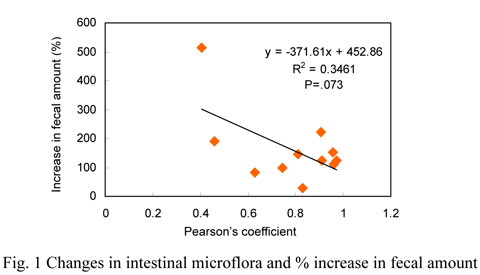- TOP
- List of reports
- Effects of Chlorella supplement on intestinal environment, such as improvement of constipation
Effects of Chlorella supplement on intestinal environment, such as improvement of constipation
【Scientific information】
Research and Development Department, Sun Chlorella Corporation
Effects of Chlorella supplement on intestinal environment, such as improvement of constipation
Presented at the 13th Annual Meeting of the Japanese Society for Complementary and Alternative Medicine (2010)
- Study Objectives
- Constipation is a common problem in women and elderly individuals. It compromises the intestinal environment and increases the products of intestinal putrefaction, which may significantly damage the patient's health by decreasing immunity, increasing the risk of cancer, and aging. Chlorella is rich in dietary fibers, amino acids, vitamins, and minerals. We studied the effects of Chlorella on constipation and intestinal microflora in the intestinal environment.
- Method of experiments
- The subjects of the study were 11 women with constipation tendency (defecation frequency of 3–5 times/week). The total study period was 5 weeks. The subjects took 40 Chlorella tablets (8 g) for 3 weeks, followed by a 2-week withdrawal period. To investigate the effects of Chlorella supplementation, the subjects recorded the fecal amount and defecation frequency every day. Feces were sampled 3 times in total, namely, before treatment (D0), at the end of treatment (D21), and after withdrawal (D35), to analyze the intestinal microflora by Nagashima's method of terminal restriction fragment length polymorphism (T-RFLP)1). The subjects also documented the contents of meals every day.
- Results
- Chlorella increased both fecal amount and defecation frequency compared with those before treatment (Table 1).
- The overall composition of intestinal microflora showed a 20% change between before and after treatment (D0 and D21) in 4 of the 11 subjects. The intestinal microflora needs to be evaluated based on its overall composition. Currently, however, we do not have sufficient data to clarify the correlation between intestinal microflora composition and health condition. In our study, we used a change in the composition of each bacterial group as a measure of the 3-2 effectiveness of Chlorella. The one or more compositions among Bifidobacterium, Lactobacillus, or Bacteroides increased by 30% in 7 of the 11 subjects (Table 2). Bacteroides have been reported to exert a more potent intestinal immunostimulatory action than Lactobacillus.
- There was a tendency of inverse correlation between the % increase in the fecal amount and the % change in intestinal microflora (Fig. 1). This finding indicates that subjects with a large change in intestinal flora tend to defecate more.
- The study showed that Chlorella supplement significantly increased fecal amount and defecation frequency, which appear to be attributable to the nutrients contained in Chlorella, including dietary fibers and minerals. The study also suggested that Chlorella changes the intestinal microflora and thereby contributes to improvement of the intestinal environment. To confirm this assumption, however, further studies need to be accumulated.



Terminology
- 1) Nagashima's T-RFLP method
- While the conventional culture method identifies only approximately 20–30% of the overall intestinal bacterial population, this technique allows comprehensive analysis of the intestinal flora to some extent by utilizing bacterium-specific DNA.
Presentation at a scientific meeting
- Name of meeting:
- The 13th Annual Meeting of Japanese Society for Complementary and Alternative Medicine (2010)
- Title:
- Effects of Chlorella supplement on the intestinal environment of women with constipation
- Presenters:
- Hideo Takekoshi, Masako Saito, and Hirofumi Chubachi
- Affiliation:
- Sun Chlorella Corporation





